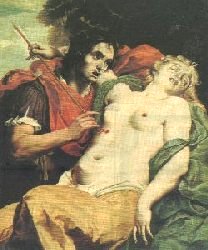 |
Ars Nova, Classical Gas
... The Good Stuff
'Dying Procris' another
in series of women victims
By Joan Altabe
ART CRITIC
Just as the taste for, say, squid, is aquired, so baroque painting
takes getting used to. Wildly emotional, wearing their hearts om their pulsing picture
planes, baroque paintings bear the melodramatic air of a Cecil B. DeMille spectacular -
gushing, gaudy and grandiose, not to mention turgid and lurid.
Enter "Cephalus Grieving Over the Dying Procris," painted by Flemish
baroque artist Abraham Janssens in 1610 - the Ringling Museum's recent $110,000 purchase.
Think of the naked woman roped to the back of the rearing bull - Ringling Museum's
life-size sculpture "Lygia and the Bull" by Gioseppe Moretti. But take away the
bull, and you've got a picture of what the dying Procris looks like: a nude woman lying
helpless on her back. |
 |
Like the sculpture, the painting is supposed to illustrate a
myth of old, but by the look of "Cephalus Grieving Over the Dying
Procris," the myth was an excuse for Janssens to make a prurient picture. Unless the
painter thought that a woman stabbed to death would show open delight at the thought, her
sexual excitement mounting clearly within her dying body. How else to explain her very
noticeable and very erect nipples?
In fact, if you didn't know the legend, the shuddering sight that you imagine
coming from the dying Procris would seem to come from a woman in extasy. She even holds
the spear that pierces her tenderly, as if she takes pleasure in being penetrated by it -
blood dripping down into her darkened crotch notwithstanding.
More about this in a minute. First the myth: According to the original Greek
version, the love between a pair of newlyweds ends in tragedy, although a version by 15th
century Italian writer Niccolo da Corregio shows a happy ending. Both versions, however,
begin the same:
The goddess Aurora falls for Cephalus, who scorns her. Bitterly, she encourages him
to test his wife's fidelity by attempting to seduce her disguised as someone else.
Embarrassed that she almost yields, Procris flees and joins the goddess Diana, who gives
her a hunting dog and spear to give to Cephalus as a peace offering. Meanwhile a faun who
has fallen for Procris fills her with suspicion about Cephalus' fidelity, so she hides in
some bushes to spy on him. As the leaves of the bushes rustle, he throws his spear at it
and kills her.
In the Italian version, Dianan revives the wife.
It's odd that Janssens chose the tragic Greek ending over the happy Italian one
because his work shows an otherwise-Italian influence. This is particularly apparent in
the use of strongly contrasting light and shade - a style made famous bu 17th century
Italian painter Michelangelo Merisi da Caravaggio.
But the exposed flesh is my beef.
Nudity is a legitimate device in art to convey the idea of vulnerability. It is a
way of expressing defenselessness. In the Ringling Museum's "Susannah and the
Elders" by Sisto Badaloccio, well- covered elders eyeball an undressed Susannah,
making her a vision of assailability.
Similarly, the museum's "Perseus and Andromeda" by Cavaliero d'Arpino,
showing a naked woman chained to a rock and being attacked by wild animals, is another
effigy of powerlessness.
In contrast, the female form au naturel in "Cephalus Grieving Over
the Dying Procris," nailed by a spear like a pinned butterfly, has nothing to do with
susceptibility (She was on the prowl, spying on her husband, don't forget.). Instead, the
painting appears to celebrate the aged-old fondness for painting nude women in
compromising positions. I'm thinking of Cezanne's "The Stangled Women,"
"The Murder" and "The Rape."
A media release from the museum says the focus of the painting is on the husband's
realization that he accidently killed his wife. While it's true that the husband looks
upset as he holds his dying wife, he's not the focus of the painting. The highlighted
nudity of his wife is what beggs for attention.
Not that Ringling Museum is the only collection of paintings of women as victims. I
can't think of a single museum with an important collection in this country or in Europe
that doesn't hold such an image.
But doesn't Ringling Museum have enough of these from the John Ringling behest? Did
it have to spend $110,000 for another?
An exhibit placard says the wife's pose is "reminiscent of Christ in
Michelangelo's 'Pieta.'"
I fail to see how museum officials can compare an accidental death by a jealous
wife perpetrated by a jealous husband to the crucified Christ.
In the words of Jesus, "Forgive them; for they know not what they do."
|

